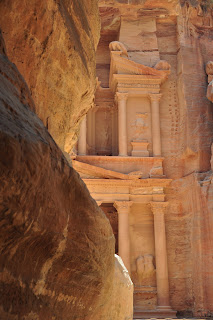Aug 7-10
Of course after almost 2 weeks of smooth sailing on the Sinai coast, the day we decide to leave I develop stomach problems and nausea.
Gus, Josh, Chris and myself were all ready to make our way to Jordan: Gus to meet up with his father who would be visiting him in Madaba, and the three of us to avoid staying in Dahab for the rest of our lives (not that it would be a bad thing).
We said goodbye to the wonderful staff at Penguin and took a bus to Nuweiba. Our original intention was to get the fast ferry to Aqaba, Jordan, and then catch a bus to Wadi Musa, home to the Wonder of the World, Petra; but since it was Ramadan, the fast ferry was not running. We would be forced to take the slow ferry.
After waiting 2 hours before boarding the ferry, we inexplicably waited for nearly another 3 hours before it finally left the port.
Rather than arriving at 1:30pm in Jordan as we had anticipated , Ramadan had foiled our plans and we only arrived after 9:00pm, well after the time to catch a public bus.
We had met some Chinese and Korean travelers on the ferry and agreed to split the cab fare to Petra with them. After some bargaining and watching cab and bus drivers face-grab and punch each other (no joke) for our money, we finally settled on the most sane taxi driver and were on our way to Petra.
We arrived to our hotel, the Saba'a Hotel (www.sabaahotel.com) after midnight and immediately passed out.
We spent our first day sleeping in, relaxing and I was hoping my stomach would improve. Unfortunately, it didn't.
On our second day, we woke up at 6:00am and proceeded to the gates of Petra. We had purchased a 2-day pass and were determined to get our money's worth (a 2-day pass costs almost 80$!)
Petra is the ancient capital of the Nabatean people, who originally migrated from the Arabian peninsula and settled in southern Jordan. They established themselves along a major trade route linking Asia to the Mediterranean and as a consequence, integrated many cultural and architectural aspects of other cultures into their own.
The Nabatean civilization was established more than 2200 years ago and were annexed into the Roman empire. Petra was gradually abandoned and forgotten until its rediscovery in 1812 by Johann Ludwing Burckhardt.
The first monument we passed was the Obelisk tomb, a clear Egyptian-Graeco-Roman influenced tomb.
Soon after, we reached the As-Siq, the ancient main entrance to the city of Petra. The Siq itself is 1.2km long and follows a natural and ancient gorge. The sandstone rock formations along the Siq are beyond impressive and display a vast palette of colours.
From the Siq, we reached the treasury or Al-Khazneh. The treasury was made famous by Indiana Jones, and is what most people think Petra is, however, it remains one of the most stunning remnants of Nabatean architecture and design. Since we were there before 8am, we got to enjoy the treasury before the scores of tourists arrived in the afternoon.
We continued from there past the Royal tombs and the theatre until we reached the beginning of the staircase towards the Ad-Deir.
Most people do not realize how vast the city of Petra actually is: from the main gate to the treasury alone takes around 45 minutes. By the time you climb the 800 steps towards the monastery, we had been walking for nearly 3 hours! However, it is more than worth it!
The monastery, or Ad-Deir, is Petra's second most famed attraction, resembling the treasury in design, but dwarfing it in size. With the effort and time it took to visit it, I could just imagine the blood, sweat and tears it took to construct it.
Truly humbling.
For the rest of the day, we took our time exploring the city and enjoyed the incredible relief created by the sandstone. It is hard to believe that the patterns and colours are natural and not from a master's paint brush.
After almost 8 hours at the site, we decided to call it a day.
The following day, we headed to Petra in the late afternoon and made our way towards Jabal al-Khubtha. The trail itself wasn't long, but it was steep and comprised hundreds of stairs. At the top we got an incredible view of central Petra and the surrounding mountains. We followed another trail and were now above the treasury. Simply amazing.
We spent a good hour gazing at this rock-hewn masterpiece before returning to the summit to watch the sunset over Petra.
With its endless array of temples, beautiful and colorful geological formations, and incredible level of preservation, it is no wonder why Petra is now one of the new Wonders of the World.
With so many layers of beauty and architectural marvels, can you truly put a price on that?
I think not.




















No comments:
Post a Comment